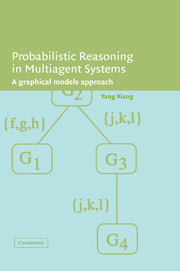Book contents
- Frontmatter
- Contents
- Preface
- 1 Introduction
- 2 Bayesian Networks
- 3 Belief Updating and Cluster Graphs
- 4 Junction Tree Representation
- 5 Belief Updating with Junction Trees
- 6 Multiply Sectioned Bayesian Networks
- 7 Linked Junction Forests
- 8 Distributed Multiagent Inference
- 9 Model Construction and Verification
- 10 Looking into the Future
- Bibliography
- Index
9 - Model Construction and Verification
Published online by Cambridge University Press: 31 August 2009
- Frontmatter
- Contents
- Preface
- 1 Introduction
- 2 Bayesian Networks
- 3 Belief Updating and Cluster Graphs
- 4 Junction Tree Representation
- 5 Belief Updating with Junction Trees
- 6 Multiply Sectioned Bayesian Networks
- 7 Linked Junction Forests
- 8 Distributed Multiagent Inference
- 9 Model Construction and Verification
- 10 Looking into the Future
- Bibliography
- Index
Summary
In Chapter 7, we developed algorithms to compile a given MSBN into an LJF, and in Chapter 8, we described multiagent belief updating by message passing. We have not discussed how an MSBN is constructed. In this chapter, we address issues related to the construction of MSBNs. In particular, we study how to integrate an MSBN-based multiagent system from agents developed by independent vendors. As detailed in Chapter 6, an MSBN is characterized by a set of technical conditions. Because independently developed subnets may not satisfy these conditions collectively, automatic verification is required to avoid the “garbage in and garbage out” scenario. The verification process becomes subtle when agents are built by independent vendors and the vendors' know-how needs to be protected. We develop a set of distributed algorithms that verify the integrity of an integrated multiagent system against the technical requirements of an MSBN.
The motivations for multiagent distributed verification are presented in Section 9.2. Section 9.3 addresses the verification of subdomain division among agents. The concept of the interface graph is introduced to capture the knowledge of the system integrator about the public aspects of multiple agents. A simple method to verify the subdomain division using the interface graph is presented. Constructing the hypertree of the MSBN at the logical level once the subdomain division is validated is also described.
- Type
- Chapter
- Information
- Probabilistic Reasoning in Multiagent SystemsA Graphical Models Approach, pp. 215 - 273Publisher: Cambridge University PressPrint publication year: 2002



